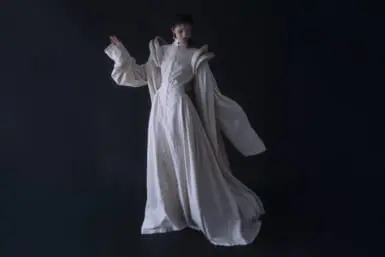This article appeared in Tokyo Weekender Vol. 1, 2025.
To read the entire issue, click here.
Colors. Glitter. Feathers. Sparkles. The protagonists in Yuri Horie’s world do not go by half-measures. She’s captured images of dekotora, which stands for “decorated truck”: hulking machines brightly outfitted in neon, gold and LED lights; of heavily tattooed lads sporting black and gold robes adorned with fur for Coming of Age Day; and of extravagantly groomed male gyaru posing in front of the Shibuya 109 department store. “All or nothing” seems to be the motto that unites her subjects — the brasher, the better. And Horie photographs them in a way that matches, or maybe even magnifies, their energy.
Horie dials into our interview from her bedroom, the wall behind her covered with a fantastic assemblage of images that inspire her, ranging from posters of the galaxy to some of her own prints. It’s exactly the sort of home environment that you’d expect from someone whose photos are so distinctive and bursting with pizzazz.
From K-Pop to Photography
Before dekotora, Horie was into K-pop. The obsession started in middle school, inspired by her younger sister. Horie went further, founding a Korean culture society at university, learning the language and even studying abroad in South Korea.
It didn’t stop there. “When I graduated, I basically got a job to fund my trips to Korea,” she says. “I’d go once every two weeks, just on the weekends.” This job happened to be in the camera industry. The company let its staff borrow cameras on their own time, and thus Horie’s foray into photography began, albeit without any major aspirations; she’d snap pictures of her friends, many of whom worked in fashion.
Her proficiency in Korean led friends in the industry to invite her to translate and interpret for them, and eventually one of them brought her to Seoul Fashion Week. “There were so many fashionable people there,” she says. “It wasn’t just the shows and celebrities — it was everyone who hoped to have their picture taken.” She photographed the scene to her heart’s content, without a specific publication in mind. That’s when it clicked for her: “More than photography, I loved meeting people. That’s what made it exciting for me.”
When she got back to Japan, Horie decided to try selling her images to magazines, making anything from ¥100 to ¥500 per street snap. “It doesn’t sound like much, but imagine selling 50 photos at ¥500 each — it all adds up,” she tells TW. This became her new way to cover her flight fees. As her work began to appear in magazines across Japan, she caught the eye of some big names in the Tokyo fashion scene: Nylon Tokyo and Drop Tokyo.
Pursuing Her Passion
This is how, just two years after her first stint in Korea, Horie found herself employed as an in-house photographer at Drop Tokyo, doing street fashion photography for them regularly, going around Tokyo with her camera in hand and approaching people with cool outfits.
“There were several photographers employed for the street snap pages,” she says. “I realized that no matter how much you sync your editing with other photographers, your own style still shows.”
In 2022, she went freelance. Working with a range of clients, she started to notice something. “I’d get people hiring me with huge mood boards that looked exactly like another photographer, and I’d think: Why didn’t you hire them? It got me down, and that’s when I decided to focus on what I really liked.”
What did you like? I ask. “Events, festivals — those sort of old cultural traditions that might be dying out,” she says. She loves to shoot at Coming of Age ceremonies, which are held across the nation annually to celebrate those turning 18 or 20 that year (depending on the municipality). Typically, men wear suits and women wear a special type of kimono called furisode — but certain towns and regions are known for going all-out.
“Some people just don’t want to bother with [the ceremonies] anymore, but I really admire those who still embrace them with gusto,” Horie continues. She admires this same sensibility in dekotora, whose owners spend huge amounts of money on making them look unique and ornate: “Some of those trucks cost around ¥100 million!”
Romanticism of the Renegade
The title of Horie’s first photobook, Roman, comes from the phrase “otoko no roman,” which loosely translates to “romanticism of the male renegade.” Her distinctive style bursts from every page — hyperbolic sparkles and movement everywhere. Photos from a Coming of Age ceremony in Kitakyushu are a particular highlight. Hardcore, tough-looking men swagger around with over-the-top hairstyles, owning their campy black and gold jackets. Turn the page, and you’ll find dekotora in all their glory, sparkling lights and glitter galore.
Horie was adamant that she wanted people to enjoy the book’s launch “like a theme park.” She held an exhibition, which opened in May of last year, featuring experience boxes, things to touch, feel and smell, and its own purikura photo booth. One of the rooms was pitch-black. Viewers were challenged to use their phone lights to find black-and-white prints scattered throughout in a sort of conceptual scavenger hunt.
Shortly after the exhibition, she was enlisted to take behind-the-scenes photos of Megan Thee Stallion and Yuki Chiba on set at the shooting for their “Mamushi” video. Her photos of the pair see them crammed into the frame, surrounded by a sea of bodies, each clamoring to be seen. It’s dynamic and artfully chaotic — the embodiment of a true Yuri Horie shot. An offhand comment of Horie’s makes a lot of sense: “I’m not a minimalist by any means. I’m always a maximalist.”
Follow Horie on Instagram.

















